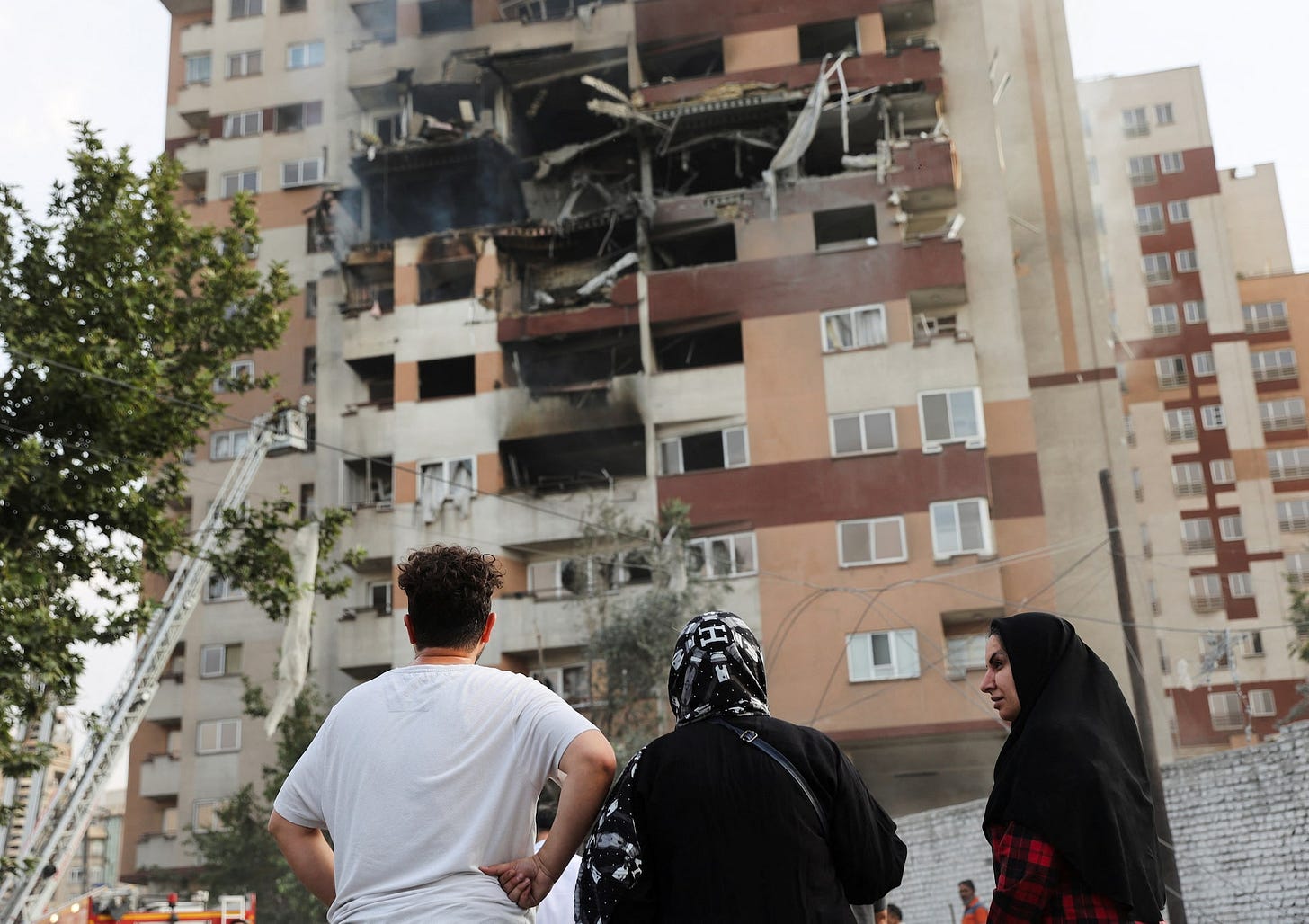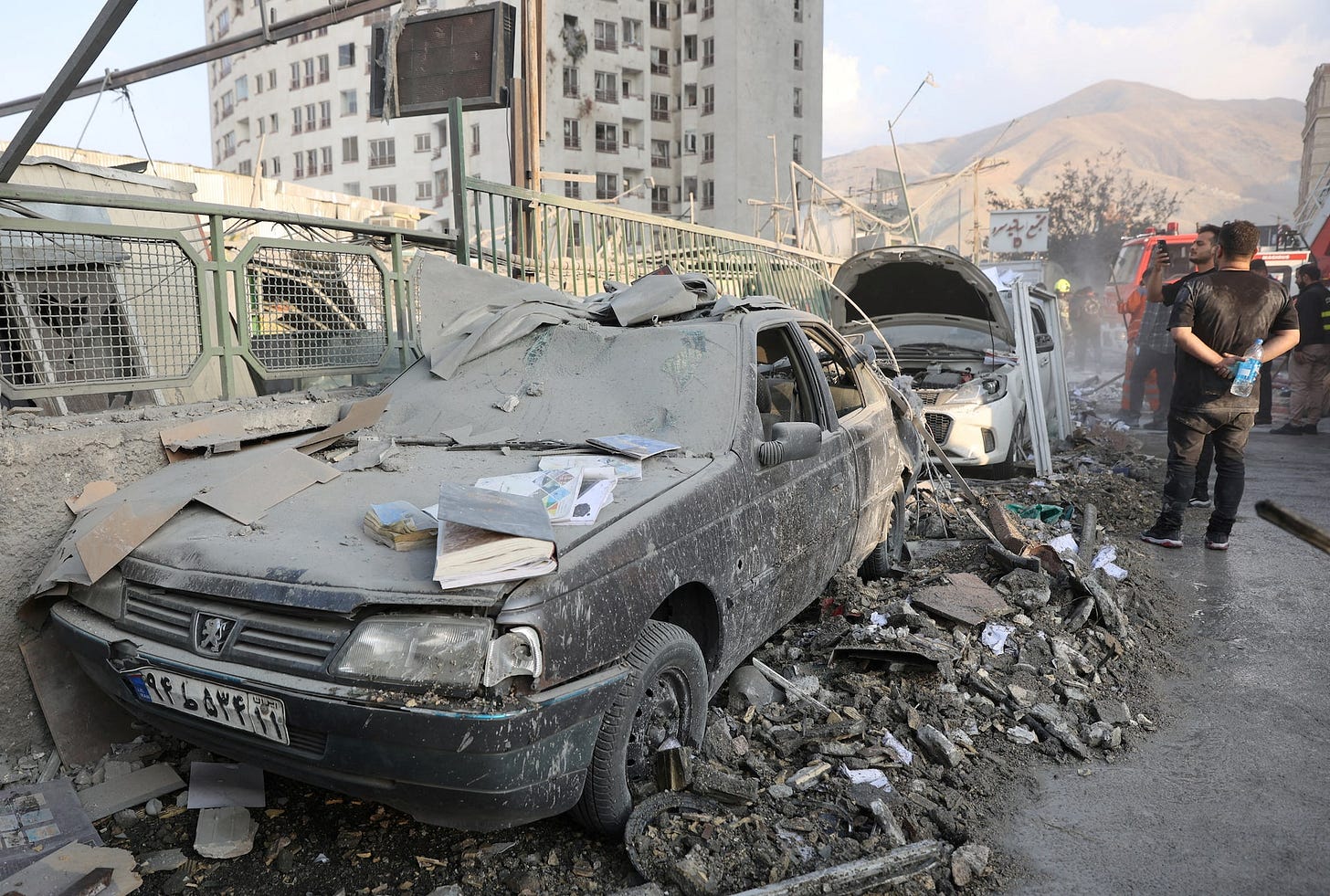Destruction of War - HamMihan’s report from neighbourhoods in Tehran attacked by Israel
Part 1 of report by Elnaz Mohammadi, Sara Sabzi; published Sunday June 15th 2025, in daily newspaper HamMihan
Until 2PM Friday, firefighters had pulled 8 people from under the rubble in Ashuri Alley in Patrice Lumumba district - 8 dead people. It is now the afternoon after the attack. War has started; men, women and children stare at the mechanical loader going up and down amidst all the dust, holding their phones and whispering the news to each other with shocked and astounded eyes. They stare at the empty space left by their neighbours and friends, a giant hill of rubble and metal. Debris removal machines slowly pick up what’s left of the house and load the trucks waiting at the end of the street; the debris of Ahmad Zolfaghari’s house, a nuclear scientist who was targeted by Israeli airstrike at 3AM on June 13th - his and his son’s body were still not recovered 23 hours after the attack. Two firefighters who have sat down for a small break a few steps away from the site tell us this, as they give us the news of the 8 people killed in this attack.
At 3AM on June 13th, Israel started its attacks on different sites in Tehran, Isfahan, Hamedan, Khorram Abad, Boroujerd, Tabriz, Piranshahr, Kermanshah, Ilam and Arak. From the first hours, in addition to military sites, Israel targeted residential areas in the neighbourhoods of Gheytarieh, Niavaran, Chitgar, Mahallati Complex, Chamran Complex, Kamranieh, Narmak, Sa’adat Abad, Shahran, Patrice Lomomba, Daghayeghi Complex and Garmdarreh [in Tehran]. These were places of residence of a number of Sepah [IRGC] commanders and six nuclear scientists and along with their assassination, many citizens also lost their lives. As Fars News Agency reported, the number of those killed in Israel’s terrorist attacks in Tehran stands at 78 until the end of Friday; at the time of writing this piece there are no updates on the number of deceased, but according to the Health Ministry the number of injured has reached 800 people.
Āshūri alley is closed off with a yellow tape and the sound of loaders continues non-stop. Both houses adjacent to where the missile hit have been damaged and evacuated; like Parsa’s family, who lost his life due to blast wave injuries a few minutes after arriving home. Now the friends and family of 26-year-old Parsa are looking at the rubble of his house: “He was with us last night until 2 in the morning. He sustained blast injuries and died later in the hospital.” The last friend to see him, a young man with concerned and anxious eyes, with barely enough energy to utter another word, says this to HamMihan.
Residents of the houses opposite have also come out and repeat the shock of the explosion to one another, none of their houses have any glass left on their windows. People of the neighbourhood heard the sound before 3:30 and those who were closer, felt the wave from the blast more strongly; so much so that if they stood close to the windows they would have been pushed back. The strength of the explosion had reached the parked cars in the street as well, as if something had fallen on their roofs.
A woman from a house close to Āshūri alley, is watching the rubble removal from behind the yellow tape. She felt the wave of the blast in her home too. After the attack on Ahmad Zolfaghari’s house, she was standing in front of the window to figure out where that frightening and continuous sound was coming from. But the blast wave pushed her back: “we didn’t know where to go, if it was an earthquake we’d say we have to go somewhere sturdy, but where to go for this? We don’t event know where they are hitting from.” The rest of the neighbours also didn’t know where they had to go after the attack. The young man who lived a few buildings further from the place of explosion also didn’t know if he had to leave or stay in his house.
A bright light, sound of explosion, the sudden opening of doors and windows; that’s how he had understood the attack: “first there was a sound and we thought it was thunders. I went to my mum so she wouldn’t be scared, but the next rocket came with a loud noise and a light like fireworks and hit the building really hard and everything started shaking.” It was as if a storm had hit: “I got confused for a moment. There was a lot of smoke and I could smell something burning, my eyes were burning. We found out who lived in this building when we came down a couple of hours afterwards.” Neighbours still don’t know the exact name of the person whose flat was targeted. In the neighbouring alleys’ houses colourful blankets have replaced the shattered windows and there are broken pieces of glass everywhere. In the midst of rubble removal, a woman stares in disbelief to her house, damaged in the explosion.
She has just found out and rushed here. District police had told residents of buildings with heavier damage to inform the police of the homes that were damaged and had to be evacuated, these were to remain locked. The apartments nearby do not have gas or electricity for the ongoing rubble removal, the residents of the two houses adjacent to the targeted house have been completely evacuated. Residents of the house that shared a wall with the targeted house, had run out to the street at the time of the explosion with their pyjamas, phones, and fear engulfing them. Now they don’t know if they can go back to a house with gaps between the walls of its rooms and the next-door apartment filled with rubble and dust. Their friends and family have rushed to get to them, and help them find shelter.
The young daughter of the family had seen “something like fire” lighting up, but it was the light from a missile: “They hit two rockets here, I saw the second one myself that came with light and hit the house.” After the first rocket, she had run inside the house to her father: “I said dad, Israel has hit us, but he said it’s probably a fire in someone’s house.” With the blast of the second explosion the shattered glasses dropped on her father’s head, injuring him: “we alone saw 14 dead bodies.” Now the coroner’s car is parked a bit further down, waiting to transport the rest of lost bodies.
Houra is a woman who lives in Patrice Lumumba street with her husband, in a house that is only a short distance away from the targeted nuclear scientist’s house. The northern wall of their house is destroyed and their building has been fully evacuated: “I think it was around 3:30 in the morning but I’m not so sure because we were asleep and were woken up by the sound of explosion, the ground shaking and the thick gas in the air. The northern part of our house has been destroyed and so it was hard to get out of the house. I wrote on X because I couldn’t call anyone.” But when she wrote on X network that “our home was destroyed”, social media had not yet become full of the news of war: “That’s why I wrote there, because I couldn’t understand what had happened and only wanted to inform that this had happened here.” Their home is a flat in a 4-storey building with single units on each floor, and Houra and her husband live on the third floor. She describes the destruction caused by the blast to their building to HamMihan as follows: “living room and kitchen are on the northern side of the flat and the bedrooms are at the southern side. We were in our bedroom and across from us, the wall had completely collapsed. At first I thought our building has been completely destroyed, because at first there was a thick white gas or smoke and I couldn’t see anything. Later we saw that the other side of the flat has been destroyed; as if all the furniture from that side had been pushed to this side.
There is a corridor between the living room and the bedrooms, all the furniture had filled this space and we thought we’d been trapped.” They had to leave their flat because it was not habitable: “the first and second floor were not as damaged as ours, and I didn’t see the fourth floor and I don’t know about that. But our flat was damaged much more than the first and second.” When Houra and her husband got outside to the street, they saw other people had also come to the streets: “I still don’t fully understand what has happened. Now that I think about it I cannot remember a lot of things, it was a really scary scene. At first I thought it was the thunder or an earthquake because the building was shaking so much. When we got downstairs, the neighbours told us they had hit the other side with a rocket and we saw the fire there before coming downstairs.”
Some people had also been injured in their building: “one person who had been sleeping in the living room had a cut in their head from broken glass. When I saw them they were totally fine but because of the strength of the blast they were curled up and cuddling themselves. Another neighbour had bloody clothes but I checked their body and they were fine.”
They went back to their flat at 10am to gather up some personal stuff, but they saw some people around the building who didn’t let them go inside. Houra thought they were “strange”: “when we got back a few people from the emergency services came and didn’t let us go inside. Some strange people kept passing by and making odd comments. Some with walkie-talkies or on motorcycles. A few people also said they were from the crisis management unit and asked what had happened, I showed them videos of the flat, they said they wanted to know how much damage there had been.” Houra also informs us about contact between officials and a neighbour who had told them not to worry about housing: “our whole building has been evacuated and the one next to us is also badly damaged and not suitable for staying in.
But the rest of the buildings in the street, all their windows have broken because of the explosion. It was so strong that the windows of buildings across the street have also broken from both sides.” As she notes, there was only a northern courtyard between their house and where the target was, but the buildings next to the target, were actually damaged more and some residents were killed: “When we went back for our stuff, we saw the house that was hit with the rocket was no longer there, the building next to it was also destroyed and we heard there were some people killed there.”
Parniya, Tara, Majid
Around the same time, there are emergency cars in the middle of ShahrAra street and the rubble removal continues in Orkideh Complex. ShahrAra is closed off from Mohammadi Street onwards with a yellow tape and cars are not permitted to pass through. People have gathered since the morning in front of a building that has a wall of one of its rooms completely destroyed, to see with their own eyes that a residential non-military building in the West of Tehran has been targeted by an Israeli missile. How many times have they repeated these sentences to themselves to be able to believe them? Some of them say it’s as if after the news of the past week they were ready to wake up one night to the sound of explosions. Due to the rubble removal nobody is allowed to enter the complex, but the blast has broken off a wall from the apartment block opposite, which can be clearly seen from the street.
The building that was targeted by a missile, was the residence of Abdolmajid Minuchehr, the head of engineering department at Shahid Beheshti University. A four-storey building in Orkideh Complex on Shahran Street the top two storeys of which had collapsed on the lower ones - where Parniya Abbasi and her family lost their lives. It’s the same building were friends of Tara Haji Miri and her gym coach were looking for a sign of her. They had asked a man holding a list of names of the recovered bodies, and had finally seen her body on the morgue’s list; Tara daughter of Ebrahim. The girl’s uncle had managed to identify her, the bodies of the father and mother had been under the rubble until that time - all three members of Haji Miri family were killed in this explosion.
Apart from them, there was another woman also looking for a lost loved one among the rubbles of Orkideh Complex; the sister of a man named Majid - the blast had thrown his pregnant wife onto a tree opposite the flat, but she had survived. In that moment as the woman was sitting on the floor by the wall of Orkideh Complex watching the rubble removal, she was notified that she had to go for a DNA test; maybe one of the unidentified bodies was her brother. The loaders were still working, people were still standing in front of the Complex and the street would not empty of people.
End of first part of report. Read the full article in Farsi here.






